buttons Alfa Romeo 156 2005 Owner handbook (in English)
[x] Cancel search | Manufacturer: ALFA ROMEO, Model Year: 2005, Model line: 156, Model: Alfa Romeo 156 2005Pages: 357, PDF Size: 5.04 MB
Page 26 of 357
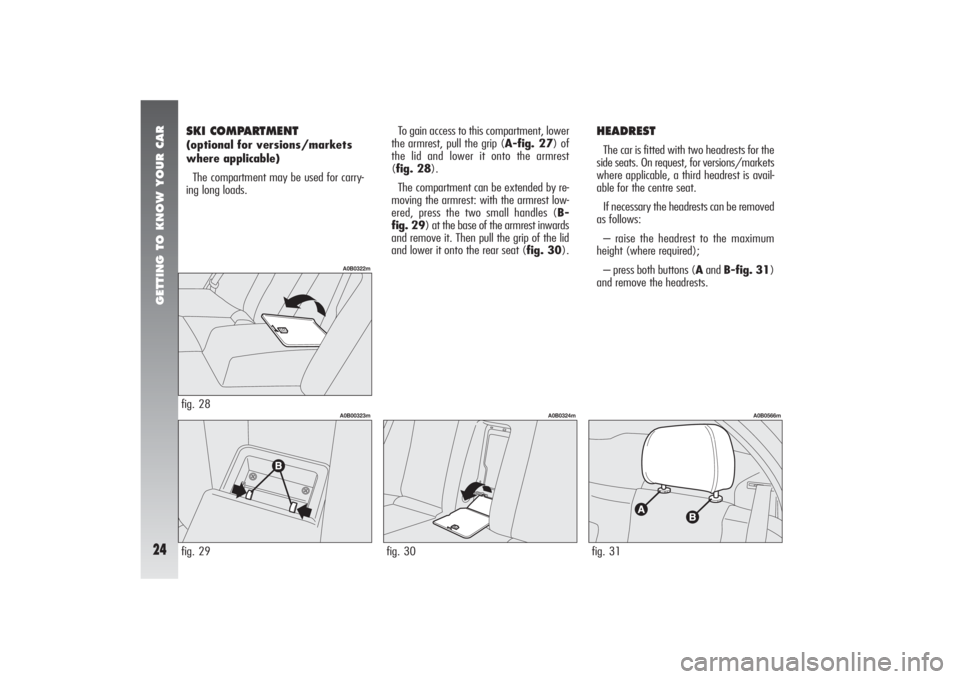
GETTING TO KNOW YOUR CAR24
SKI COMPARTMENT (optional for versions/markets
where applicable)
The compartment may be used for carry-
ing long loads.To gain access to this compartment, lower
the armrest, pull the grip (A-fig. 27) of
the lid and lower it onto the armrest
(fig. 28).
The compartment can be extended by re-
moving the armrest: with the armrest low-
ered, press the two small handles (B-
fig. 29) at the base of the armrest inwards
and remove it. Then pull the grip of the lid
and lower it onto the rear seat (fig. 30).
HEADREST The car is fitted with two headrests for the
side seats. On request, for versions/markets
where applicable, a third headrest is avail-
able for the centre seat.
If necessary the headrests can be removed
as follows:
– raise the headrest to the maximum
height (where required);
– press both buttons (Aand B-fig. 31)
and remove the headrests.
fig. 28
A0B0322m
fig. 29
A0B00323m
fig. 30
A0B0324m
fig. 31
A0B0566m
Page 29 of 357
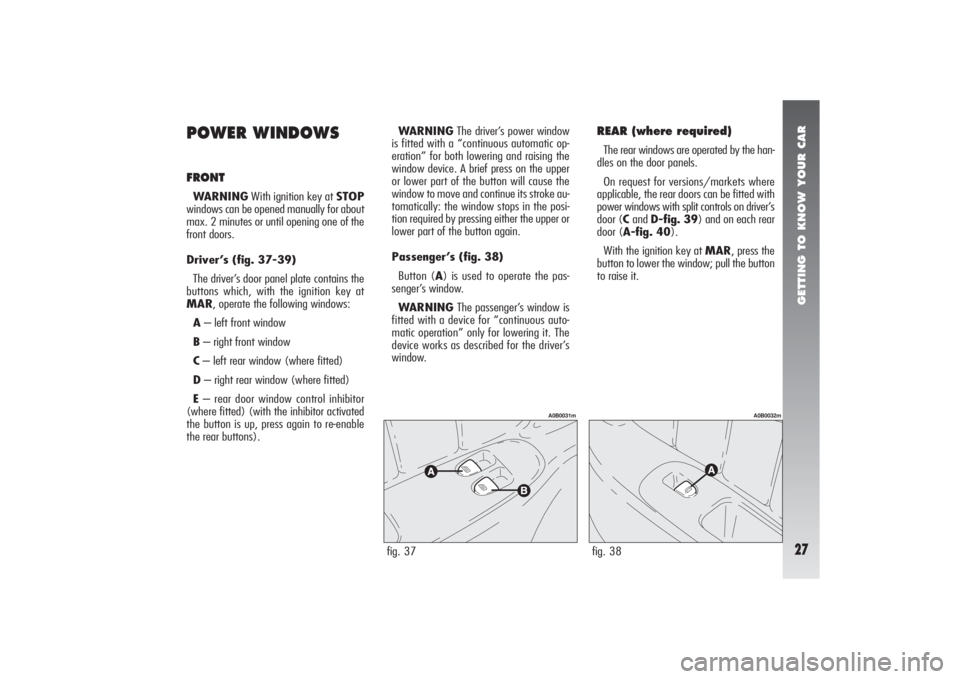
GETTING TO KNOW YOUR CAR27
POWER WINDOWSFRONTWARNINGWith ignition key at STOP
windows can be opened manually for about
max. 2 minutes or until opening one of the
front doors.
Driver’s (fig. 37-39)
The driver’s door panel plate contains the
buttons which, with the ignition key at
MAR, operate the following windows:
A– left front window
B– right front window
C– left rear window (where fitted)
D– right rear window (where fitted)
E– rear door window control inhibitor
(where fitted) (with the inhibitor activated
the button is up, press again to re-enable
the rear buttons).WARNINGThe driver’s power window
is fitted with a “continuous automatic op-
eration” for both lowering and raising the
window device. A brief press on the upper
or lower part of the button will cause the
window to move and continue its stroke au-
tomatically: the window stops in the posi-
tion required by pressing either the upper or
lower part of the button again.
Passenger’s (fig. 38)
Button (A) is used to operate the pas-
senger’s window.
WARNINGThe passenger’s window is
fitted with a device for “continuous auto-
matic operation” only for lowering it. The
device works as described for the driver’s
window.
fig. 37
A0B0031m
fig. 38
A0B0032m
REAR (where required)The rear windows are operated by the han-
dles on the door panels.
On request for versions/markets where
applicable, the rear doors can be fitted with
power windows with split controls on driver’s
door (C and D-fig. 39) and on each rear
door (A-fig. 40).
With the ignition key at MAR, press the
button to lower the window; pull the button
to raise it.
Page 32 of 357
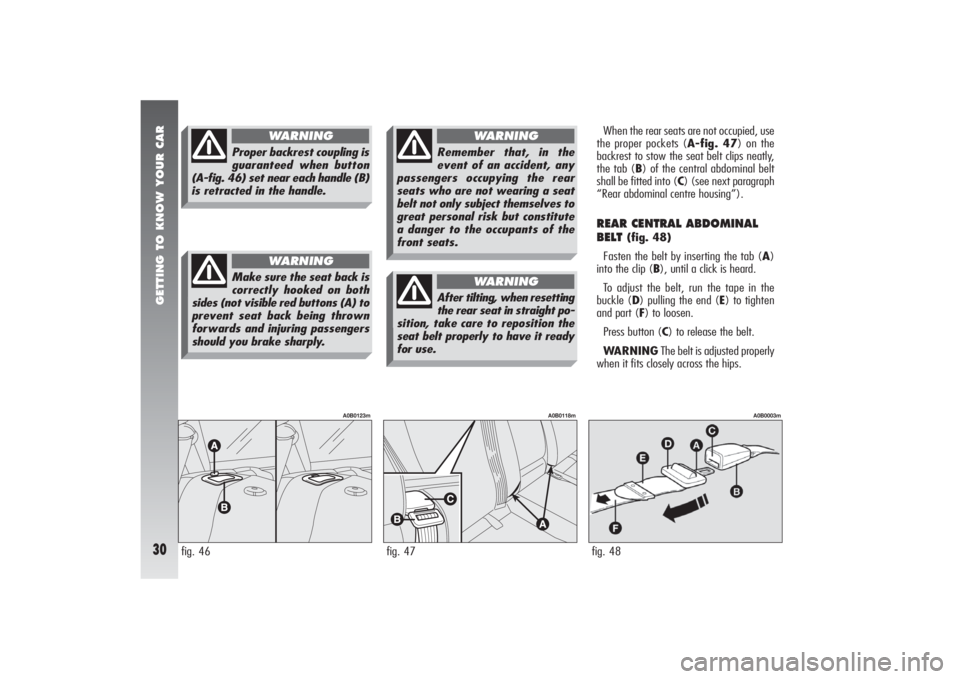
GETTING TO KNOW YOUR CAR30
When the rear seats are not occupied, use
the proper pockets (A-fig. 47) on the
backrest to stow the seat belt clips neatly,
the tab (B) of the central abdominal belt
shall be fitted into (C) (see next paragraph
“Rear abdominal centre housing”).REAR CENTRAL ABDOMINAL
BELT
(fig. 48)
Fasten the belt by inserting the tab (A)
into the clip (B), until a click is heard.
To adjust the belt, run the tape in the
buckle (D) pulling the end (E) to tighten
and part (F) to loosen.
Press button (C) to release the belt.
WARNINGThe belt is adjusted properly
when it fits closely across the hips.
fig. 47
A0B0118m
fig. 48
A0B0003m
Remember that, in the
event of an accident, any
passengers occupying the rear
seats who are not wearing a seat
belt not only subject themselves to
great personal risk but constitute
a danger to the occupants of the
front seats.
WARNING
After tilting, when resetting
the rear seat in straight po-
sition, take care to reposition the
seat belt properly to have it ready
for use.
WARNING
fig. 46
A0B0123m
Make sure the seat back is
correctly hooked on both
sides (not visible red buttons (A) to
prevent seat back being thrown
forwards and injuring passengers
should you brake sharply.
WARNING
Proper backrest coupling is
guaranteed when button
(A-fig. 46) set near each handle (B)
is retracted in the handle.
WARNING
Page 65 of 357

GETTING TO KNOW YOUR CAR63
MILEAGE DISPLAY
(with double meter display)The display shows:
– the mileage on the first line (6 figures)
– the trip meter on the second line (4 fig-
ures)
To reset the trip meter, keep button (A-
fig. 84) pressed for a few seconds.fig. 84
A0B0489m
INFOCENTER DISPLAY
RHEOSTAT LIGHTS
ADJUSTMENT (where
required)This function makes it possible to adjust
the brightness (dimming/brightening) of
the Infocenter display during night and day.
To perform the desired brightness adjust-
ment (night or day), use buttons
â
or ã
,
bearing in mind that:
– if the outside lights are on, the message
BRIGHTN. ADJUST. NIGHT will appear on the
display (fig. 85)
– if the outside lights are OFF, the mes-
sage BRIGHTN. ADJUST. DAY will appear on
the display (fig. 86).Pressing button
â
, or after about 5 sec-
onds from last operation performed, returns
to previous screen.
WARNING During failure indication dis-
playing, brightness cannot be adjusted since
under these conditions the display gets au-
tomatically to max. brightness.
fig. 85
A0B2124g
fig. 86
A0B2125g
Page 66 of 357
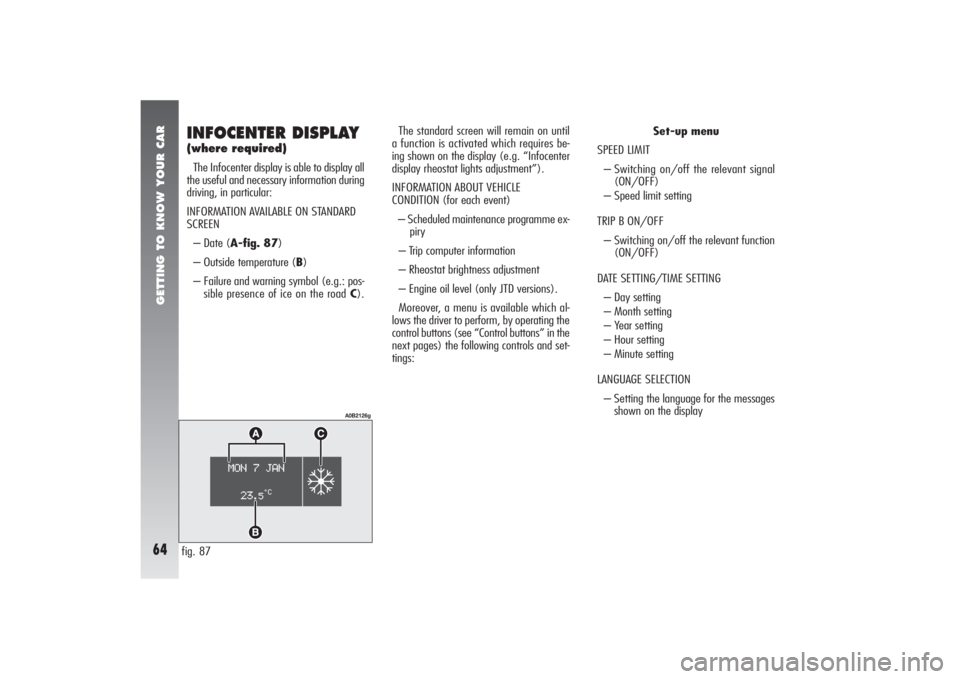
GETTING TO KNOW YOUR CAR64
INFOCENTER DISPLAY(where required)The Infocenter display is able to display all
the useful and necessary information during
driving, in particular:
INFORMATION AVAILABLE ON STANDARD
SCREEN
– Date (A-fig. 87)
– Outside temperature (B)
– Failure and warning symbol (e.g.: pos-
sible presence of ice on the road C).The standard screen will remain on until
a function is activated which requires be-
ing shown on the display (e.g. “Infocenter
display rheostat lights adjustment”).
INFORMATION ABOUT VEHICLE
CONDITION (for each event)
– Scheduled maintenance programme ex-
piry
– Trip computer information
– Rheostat brightness adjustment
– Engine oil level (only JTD versions).
Moreover, a menu is available which al-
lows the driver to perform, by operating the
control buttons (see “Control buttons” in the
next pages) the following controls and set-
tings:Set-up menu
SPEED LIMIT
– Switching on/off the relevant signal
(ON/OFF)
– Speed limit setting
TRIP B ON/OFF
– Switching on/off the relevant function
(ON/OFF)
DATE SETTING/TIME SETTING
– Day setting
– Month setting
– Year setting
– Hour setting
– Minute setting
LANGUAGE SELECTION
– Setting the language for the messages
shown on the displayfig. 87
A0B2126g
Page 68 of 357
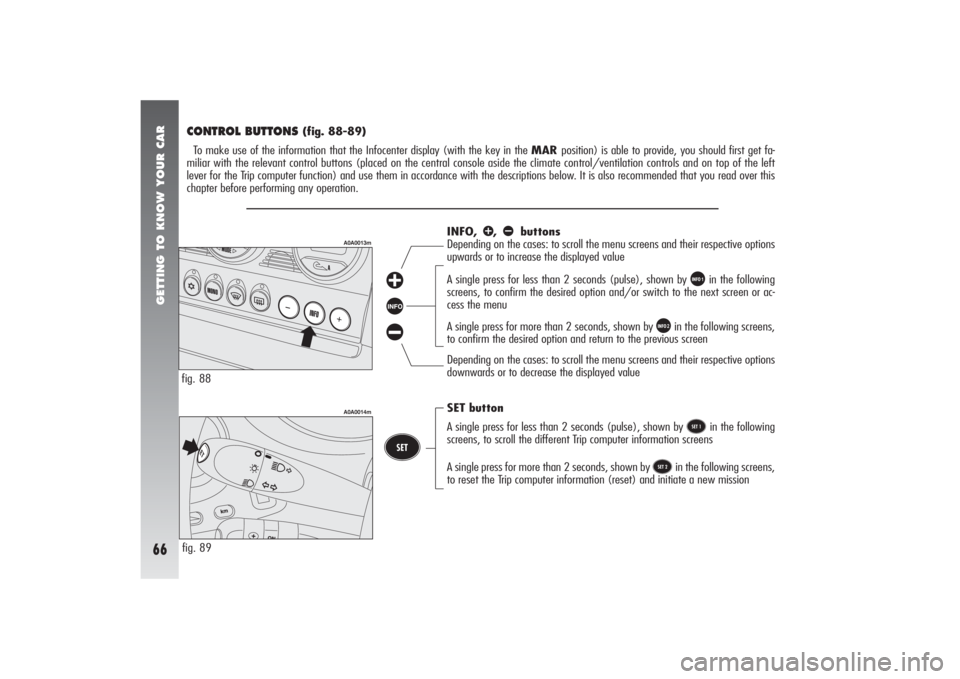
GETTING TO KNOW YOUR CAR66
CONTROL BUTTONS
(fig. 88-89)
To make use of the information that the Infocenter display (with the key in the MAR position) is able to provide, you should first get fa-
miliar with the relevant control buttons (placed on the central console aside the climate control/ventilation controls and on top of the left
lever for the Trip computer function) and use them in accordance with the descriptions below. It is also recommended that you read over this
chapter before performing any operation.
fig. 88fig. 89
ã
SET button
A single press for less than 2 seconds (pulse), shown by
ä
in the following
screens, to scroll the different Trip computer information screens
A single press for more than 2 seconds, shown by
å
in the following screens,
to reset the Trip computer information (reset) and initiate a new mission INFO,
â
, ã
buttons
Depending on the cases: to scroll the menu screens and their respective options
upwards or to increase the displayed value
Depending on the cases: to scroll the menu screens and their respective options
downwards or to decrease the displayed value A single press for less than 2 seconds (pulse), shown by
ç
in the following
screens, to confirm the desired option and/or switch to the next screen or ac-
cess the menu
A single press for more than 2 seconds, shown by
é
in the following screens,
to confirm the desired option and return to the previous screen
A0A0013m
A0A0014m
Page 69 of 357
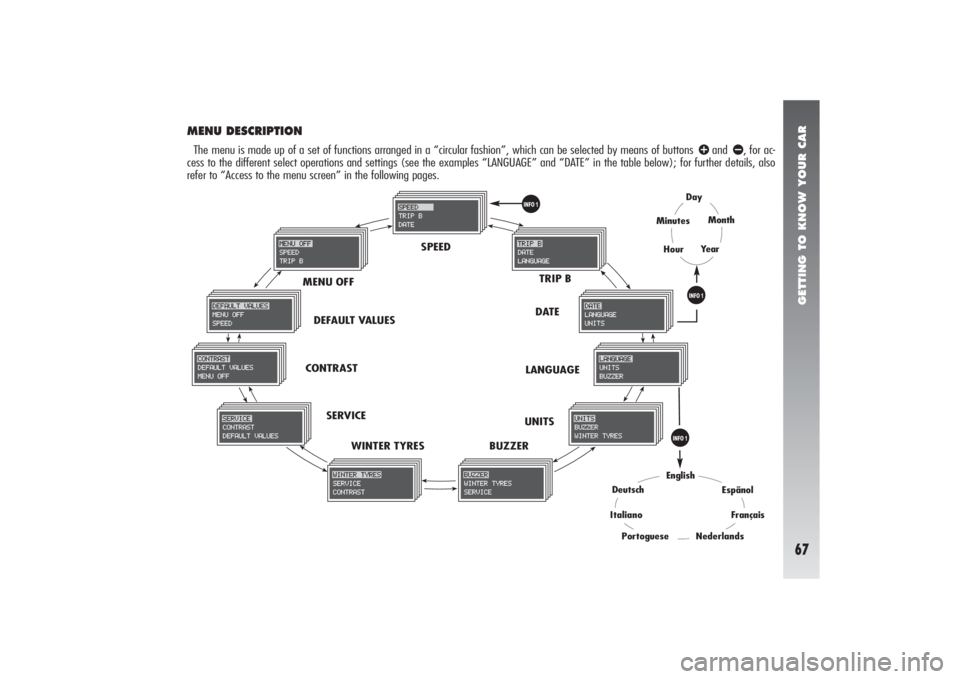
GETTING TO KNOW YOUR CAR67
MENU OFFSPEED
TRIP B
DATE
DEFAULT VALUES
CONTRAST
WINTER TYRESLANGUAGE
UNITS
BUZZER SERVICE
MENU DESCRIPTIONThe menu is made up of a set of functions arranged in a “circular fashion”, which can be selected by means of buttons
â
and
ã
, for ac-
cess to the different select operations and settings (see the examples “LANGUAGE” and “DATE” in the table below); for further details, also
refer to “Access to the menu screen” in the following pages.
English
Nederlands
EspãnolFrançais
DeutschItalianoPortoguese
Day
Minutes
MonthYear
Hour
ç
ç ç
Page 74 of 357
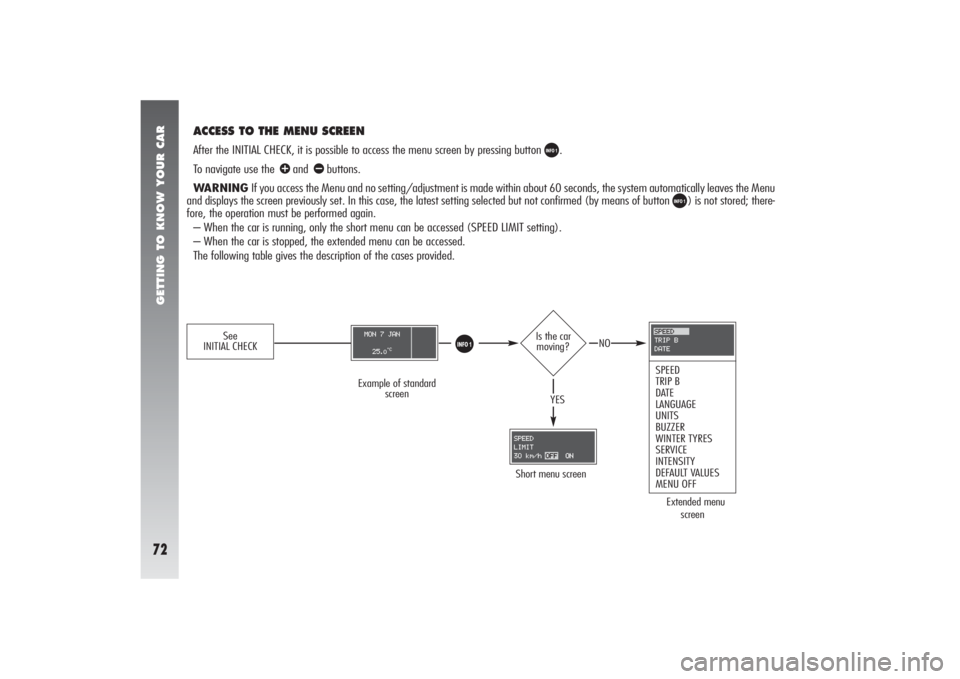
GETTING TO KNOW YOUR CAR72
ACCESS TO THE MENU SCREENAfter the INITIAL CHECK, it is possible to access the menu screen by pressing button
ç
.
To navigate use the
â
and
ã
buttons.
WARNING If you access the Menu and no setting/adjustment is made within about 60 seconds, the system automatically leaves the Menu
and displays the screen previously set. In this case, the latest setting selected but not confirmed (by means of button
ç
) is not stored; there-
fore, the operation must be performed again.
– When the car is running, only the short menu can be accessed (SPEED LIMIT setting).
– When the car is stopped, the extended menu can be accessed.
The following table gives the description of the cases provided.
Example of standard
screen
Is the car
moving?
Short menu screen
SPEED
TRIP B
DATE
LANGUAGE
UNITS
BUZZER
WINTER TYRES
SERVICE
INTENSITY
DEFAULT VALUES
MENU OFF
ç
See
INITIAL CHECK
NO
YES
Extended menu
screen
Page 75 of 357

GETTING TO KNOW YOUR CAR73
SPEED LIMIT (SPEED)With this function it is possible to set the car speed limit which, if exceeded, automatically sounds a buzzer and displays a specific message
to alert the driver. To set the limit speed, proceed as follows:
Using
â
and/or
ã
buttons to set the speed required. During the setting
operation, the value flashes on the screen. The possible setting is between 30
and 250 km/h or between 20 and 150 mph, depending on the unit
set previously (see paragraph UNITS described later). Every press (pulse)
of the button increases or decreases by one unit. Keeping the button pressed
obtains fast increase or decrease. When you are near the required setting, release
the button and complete adjustment with single presses.
Menu screen
Return
to menu screen
Return to previously
set screen, e.g. See INITIAL CHECK and
ACCESS TO THE MENU SCREEN
çéSelect, by means of buttons
â
or ã
activation or deactivation
(ON/OFF). The set option will be highlighted.
ç
ç
é
â
ã
â
ãâ
ã
é
Page 77 of 357

GETTING TO KNOW YOUR CAR75
TRIP B ON/OFF (TRIP B)With this option it is possible to turn ON or OFF the TRIP B function (partial trip) which displays the figures relating to:
TRAVEL DISTANCE B
, AVER
-
AGE CONSUMPTION B
, AVERAGE SPEED B
, TRAVEL TIME B
during a “partial mission”.
For further details, see “General Trip - Trip B”
Menu screen
Return to menu screen See INITIAL CHECK and ACCESS
TO THE MENU SCREENReturn to previously
set screen, e.g.
â
ã
â
ã
Using the
â
or ã
buttons choose activation
or deactivation ON/OFF.
The set option will be highlighted.
çé
çé